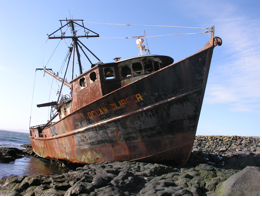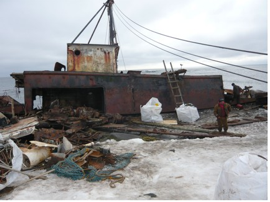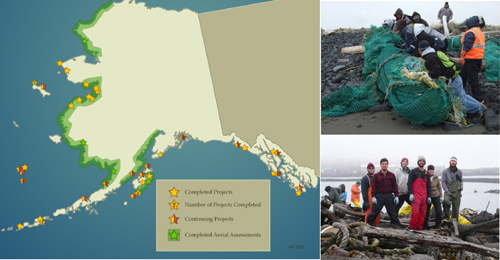Restoring Marine Mammal Habitat: The Ocean Clipper Project
SUMMARY
| St. Paul Island, Alaska is home to the world’s largest population of Northern Fur Seals. This Aleut community is also near the center of the great Bering Sea fisheries, and economically and culturally dependent on the sustainable harvest of those resources.
Shipwrecked on a fur seal rookery on St. Paul Island in the late 1980’s, the F/V Ocean Clipper became a death trap to Northern Fur Seal pups. The vessel was too rusted to haul off the reef, so it had to be removed in pieces. To make a difficult job even more challenging, the cut up ship could not be dragged across the rookery, so a unique “highline” aerial cable system was used to hoist the wrecked ship to the top of a cliff, where it could be hauled off without further damage to the rookery. The project was also a race against time, taking place between the annual breakup of ice on the Bering Sea and the arrival of the fur seals for the short summer season. To further safeguard the fur seals, lookouts were used during critical periods through the removal project. This was a large, but not totally unique marine debris/habitat restoration project for the MCA Foundation; which partnered with Magone Marine, the Aleut Community of St. Paul Island Tribal Government, NOAA, and partners under the American Recovery and Reinvestment Act of 2009. |
(Above) The Ocean Clipper ran aground on a vital Northern Fur Seal rookery on St. Paul Island, Alaska (Below) Working in sub-freezing temperatures, the ship was carefully cut apart and hauled piece by piece off the rookery using an aerial cable system. |
Habitat Restoration projects throughout Alaska
| Every year the Marine Conservation Alliance Foundation partners with local organizations around Alaska to conduct beach cleanup and habitat restoration projects. Our partners include Native Alaska tribal and city governments, commercial fishermen and processors, environmentalists, Community Development Quota groups and private businesses.
To protect our sustainable fisheries and the ecosystem that we all depend on, the program has grown to include monitoring, debris analysis, the maintenance of an extensive database, and on-going marine debris surveys. To date the program has collected over 1.5 million pounds of debris, and surveyed over 2,500 miles of coastline. |
Marine debris isn’t just an eyesore, it’s a threat to fish, seabirds and marine mammals. In 2008 the National Marine Fisheries Service awarded the Marine Conservation Alliance Foundation its Sustainable Fisheries Leadership Award for Coastal Habitat Restoration. The Marine Conservation Alliance Foundation was also awarded the 2010 Alaska SeaLife Center’s award for Stewardship and Sustainability for the program.
The Marine Conservation Alliance Foundation’s marine debris program is funded by a variety of sources including the National Oceanic and Atmospheric Administration, private industry, mitigation funding, and private donations. The FV Ocean Clipper project was funded by NOAA under the American Recovery and Reinvestment Act. |
MCAF Habitat Restoration & Marine Debris Projects |
|
| Learn what you can do to keep our oceans clean and protect important habitats: http://www.mcafoundation.org
|
|



